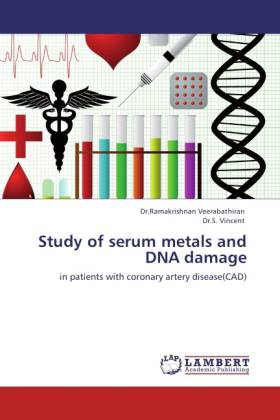
- Afhalen na 1 uur in een winkel met voorraad
- Gratis thuislevering in België vanaf € 30
- Ruim aanbod met 7 miljoen producten
- Afhalen na 1 uur in een winkel met voorraad
- Gratis thuislevering in België vanaf € 30
- Ruim aanbod met 7 miljoen producten
Zoeken
Study of Serum Metals and DNA Damage
in patients with coronary artery disease(CAD)
S Vincent, Ramakrishnan Veerabathiran
Paperback | Engels
€ 77,95
+ 155 punten
Omschrijving
Coronary artery disease (CAD) is one of the major health problems responsible for increasing mortality and morbidity all over the world. The hypothesis of the study is that elevated levels of antioxidant enzymes are associated with increased stable coronary artery disease. With this perspective in the study, the role of trace elements, lipids and antioxidant enzymes levels in the serum of patients with CAD were determined and the presence of DNA damage in peripheral blood lymphocytes in these patients was also verified. Our findings reports that the increased DNA damages are found in CAD patients' who have been analyzed for high or moderate risk of triple vessel disease by duke treadmill score (DTS) and coronary angiogram successively. Moreover evaluation of the association of angiotensin converting enzyme (ACE) gene with coronary artery disease (CAD) has suggested that there is no association of Deletion (D) or insertion (I) alleles with CAD. The study implies that the trace elements will have reliable prognostic value in the diagnosis of CAD if the investigation is carried out on the extent of the changes of these elements in CAD patients.
Specificaties
Betrokkenen
- Auteur(s):
- Uitgeverij:
Inhoud
- Aantal bladzijden:
- 224
- Taal:
- Engels
Eigenschappen
- Productcode (EAN):
- 9783846503928
- Verschijningsdatum:
- 16/09/2011
- Uitvoering:
- Paperback
- Formaat:
- Trade paperback (VS)
- Afmetingen:
- 152 mm x 229 mm
- Gewicht:
- 335 g

Alleen bij Standaard Boekhandel
+ 155 punten op je klantenkaart van Standaard Boekhandel
Beoordelingen
We publiceren alleen reviews die voldoen aan de voorwaarden voor reviews. Bekijk onze voorwaarden voor reviews.











